The ESPBoy was first built as a hackable open-source game engine and handheld console for educational purposes. However, it’s also a platform that can readily support all kinds of other uses. You can even turn the humble handheld device into a working walkie talkie.
The build relies on adding a SA868 transceiver module to the ESPBoy, along with a microphone, speaker, audio amplifier and antenna as supporting hardware. It then relies on the ESPBoy’s existing screen and buttons as a user interface for the radio. Assembled appropriately, it can then be used as a very basic and barebones walkie talkie for voice communication.
You won’t get coded squelch or other useful features, but it’s enough to let you talk over the air with other handheld radio users. The SA868 module can transmit on a variety of frequency bands, but the video shows it operating in the UHF band around 433 MHz. With a power on the order of 1.8W, it should get you a few kilometers of transmission range in an open field.
Check out our earlier coverage of the ESPBoy and its many different configurations. Video after the break.

















I would really love an ESP32 based walkie talkie with open firmware, but in a generic, ready-made enclosure with batteries and all that.
It could use UDP if wifi was available, and with GPIO pins, one could do a lot of funny things.
That sounds a lot like the Lilygo T-TWR AND T-TWR Plus boards, with a 3d printed case.
The criticism on the T-TWR boards is “ What’s missing is an audio codec for the ESP32, to implement digital voice modes.” or digital data modes (baseband).
A free audio codec, please. Not the proprietary stuff used by D-STAR, C4FM or DMR. A real, open codec, rather. Like Codec 2.
All we need is just the hardware stereo codec chip. Like a PCM2903 or overseas version. The SW codec could be a vocoder like Codec2 or modems like APRS or Packet or something else.
real codec is not free but is good in low band
What you want is an ESP32 A1S https://docs.ai-thinker.com/en/esp32-a1s
I’m really surprised this isn’t already a product considering it would probably only cost like $15 and would be so far past FRS quality there’s basically no comparison, and it’s all pretty much trivial as far as engineering, the only hard part is making them cheap enough that people want them, and don’t just say “Uh yeah I think I’ll stick with FRS because this looks like weird tinkerer crap”, which is exactly what I think whenever I see most projects.
I’d use the Opus codec, have no external radio, just ESP-NOW and WiFi, with dynamic switching (Always beacon on both, and if you see any beacons in the last five seconds on one but not the other, send audio on both, otherwise stay on WiFi).
I think I’d try to make the form factor Gridfinity stackable. The recess gives a nice lip to protect buttons anyway. I don’t think I would do any exposed GPIO pins. Those flimsy little headers and jumpers make things feel cheap and hacky. Instead I would do 2.1mm barrel jacks with protection resistors, so you could control a relay or two, or talk to some OneWire devices, and possibly add an NFC module for more advanced stuff, but generally stick to the core mission of a nice polished handheld.
Exactly! I love tinkering and 3D printing, but “real” walkie talkies have great robust enclosures and would be super easy to sell. That’s why I don’t understand why commercial ESP32 walkie talkies aren’t a thing yet?
To my surprise, some traditional walkie talkies do seem to support wifi communication – but they use some closed protocol, and you have to pay a monthly fee for the “server” (which, I guess. Is just a UDP relay). Weird.
“The build relies on adding a SA868 transceiver module to the ESPBoy, along with a microphone, speaker, audio amplifier and antenna as supporting hardware.”
Is that like adding a bathroom, kitchen, living room, bedroom, and satellite TV to my Honda?
B^)
You might be on to something there. You could even call it a “motor home”!
this is proof, every arduino/esp etc, MUST have more than 5 keys or some keys and knob
Any source for the SA868 modules – neither ebay nor ali seem to have availability?
Although, aliexpress started asking for my phone number–which they won’t be getting.
https://www.aliexpress.com/w/wholesale-SA868.html?catId=0&initiative_id=SB_20230628054851&SearchText=SA868&spm=a2g0o.home.1000002.0
AliExpress, give me direct access to PayPay or it’s all over between us.
Verify with an SMS code
We’ll send a code by SMS to your mobile number
US +1
Mobile number
The SA868 is capable of CTCSS, A shame they did not use the option.
The SA868 is notorious for spreading spurious signals all over the spectrum. Its spectral purity is totally questionnable and the level of its harmonics are illegal in any country on this planet.
You *must* use a low-pass filter with this thing which is not the case here…